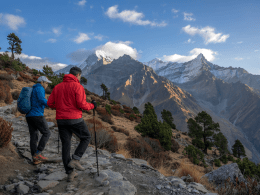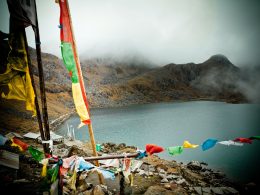Beyond the well-trodden route between Kathmandu and Pokhara, just a short, scenic drive from Damauli, lies a hidden sanctuary where divinity is said to swim in the still waters of a mountain pond. This is Chhabdi Barahi Temple, a place that defies simple description. It is not merely a temple but a living story — one written in water, stone, and the graceful dance of sacred fish.
Here, faith transcends ritual. It blossoms into a deep connection with the natural world — so sacred that when one of the temple’s fish dies, it is mourned with full Hindu death rites, the temple priest performing as its son.
The Legend of Chhabdi Barahi: Where Myth Meets Faith

Across Nepal, temple origin stories often share a divine pattern — goddesses appearing in dreams and instructing devotees to build shrines. The legend of Chhabdi Barahi in Tanahun follows this familiar rhythm, yet stands out for its rich tapestry of mythology and local folklore.
According to ancient myth, a fish in the Madi River swallowed Lord Shiva’s semen and miraculously became pregnant. When a fisherman caught the fish and cut it open, a baby girl was born. He raised her as his daughter, and over time, she became known as Matsyagandha, meaning “fish-scented.” One day, while ferrying Sage Parashar across the river, he was captivated by her presence. Shrouded in mist, the sage assaulted her — and from that tragic union was born Sage Vyasa, the legendary compiler of the Vedas and the Mahabharata. Despite her suffering, Matsyagandha — later called Satyavati — became a symbol of strength and reverence. As Vyasa matured, he honored his mother by establishing her worship at the place where she once lived — a site that came to be known as Chhabdi Barahi, near the sacred Matsya Kunda (Fish Pond). Over time, this tale merged with Tanahun’s local legend, shaping the temple’s present-day devotion.
The Local Legend: The Goddess of the Pond

In the year 1800 B.S., a villager named Jaharsingh Ale Magar from Karlung was fishing in the Chhabdi River when a mysterious young girl appeared at his hut, asking for shelter. Unable to offer her food or bedding, Jaharsingh expressed his helplessness. The girl then revealed her divine identity — she was the goddess of the pond, residing there in the form of a sacred stone (shila). She instructed him to begin daily worship and then vanished.
The next morning, Jaharsingh found a sacred stone in the pond and began to worship it. He built a small thatched hut nearby, establishing the first shrine. Later, in 1995 B.S., Man Bahadur Ale constructed a permanent temple, which served as a spiritual center for decades. Today, a mermaid-like statue of the goddess — half woman, half fish — rests in the pond, embodying both the myth and the devotion that has flowed through generations.
The Living Temple: Rituals and Renewal

The Chhabdi Barahi Temple is not frozen in history; it thrives as a living center of faith. Pilgrims believe that bathing in the sacred pond and offering sincere prayers can wash away sins and bring blessings — for health, fertility, or prosperity.
Sacred Sacrifices
Like other Barahi temples in Nepal, devotees here perform animal sacrifices — usually goats or chickens — to fulfill vows. However, certain sacred pauses preserve the temple’s serenity. No sacrifices are conducted during the month of Shrawan, on new moon days (Aausi), or on Ekadashi, making these moments ideal for peaceful visits.
Guardians of the Faith
For over twelve generations, the Aale Magar family has served as the temple’s priests and caretakers — a lineage that began with Jaharsingh Ale himself. The current priest, Chol Bahadur Aale, continues this unbroken tradition, ensuring that every ritual and offering preserves its original sanctity.
A Developing Pilgrimage Site
Today, the Chhabdi Barahi Development Fund Committee is actively enhancing the temple’s infrastructure and visitor management. Their goal is to balance spiritual preservation with sustainable tourism, ensuring that the sacred pond and its ecosystem remain undisturbed even as the site gains popularity.
A Traveler’s Experience: More Than a Day Trip

A journey to Chhabdi Barahi Temple is as much about reflection as exploration. It invites travelers to slow down, listen to stories carried by the breeze, and witness how faith has shaped this quiet corner of Nepal.
Plan an Overnight Stay
Local songwriter Sagar Udas once said, “Spend one night in Damauli and one night near Chhabdi.” This simple advice transforms a visit into an experience — allowing time to explore nearby attractions like Vyas Cave and Parashar Ashram, both steeped in ancient lore.
Local Flavors and Finds
The nearby bazaar in Damauli offers cozy lodges, homely restaurants, and colorful market stalls. Visitors can enjoy local delicacies, buy fresh fruits, vegetables, and flower offerings, or simply chat with friendly locals about the temple’s history.
How to Get There
From Kathmandu, Chhabdi Barahi is roughly 150 km away — about a 5-hour bus ride to Damauli. From Ganeshman Chowk, local vehicles make the short 7 km journey on a paved road to the temple. The route itself is scenic, winding through lush hills and riverside settlements.
A Place Where Myths Still Breathe
Chhabdi Barahi is more than a religious destination — it’s a living connection between myth, nature, and devotion. Here, the sacred fish glide through the water like silent prayers, the temple bells echo through the forested hills, and the stories of gods and humans flow together like rivers meeting the sea.
To visit Chhabdi Barahi is to witness how faith finds form in the simplest elements — water, stone, and belief — and how, even today, Nepal’s ancient legends continue to live and breathe through its people.
See Nepal in every scroll: Follow us on Facebook, Instagram, and TikTok for stories that bring the country to life.










